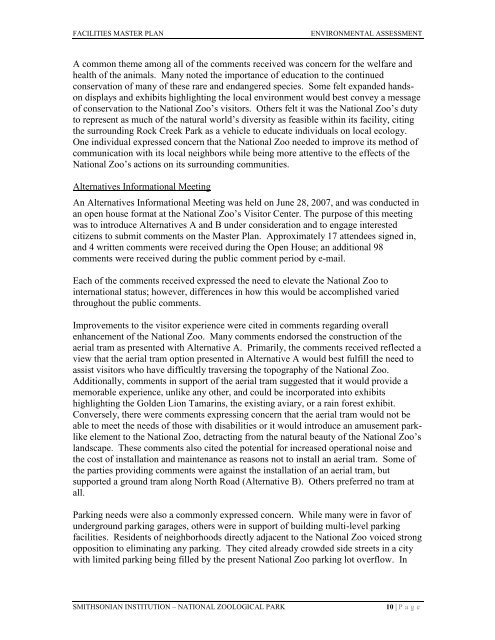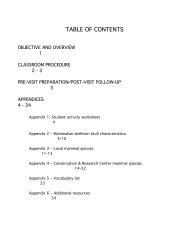facilities renewal master plan - National Zoo - Smithsonian Institution
facilities renewal master plan - National Zoo - Smithsonian Institution
facilities renewal master plan - National Zoo - Smithsonian Institution
Create successful ePaper yourself
Turn your PDF publications into a flip-book with our unique Google optimized e-Paper software.
FACILITIES MASTER PLAN ENVIRONMENTAL ASSESSMENT<br />
A common theme among all of the comments received was concern for the welfare and<br />
health of the animals. Many noted the importance of education to the continued<br />
conservation of many of these rare and endangered species. Some felt expanded handson<br />
displays and exhibits highlighting the local environment would best convey a message<br />
of conservation to the <strong>National</strong> <strong>Zoo</strong>’s visitors. Others felt it was the <strong>National</strong> <strong>Zoo</strong>’s duty<br />
to represent as much of the natural world’s diversity as feasible within its facility, citing<br />
the surrounding Rock Creek Park as a vehicle to educate individuals on local ecology.<br />
One individual expressed concern that the <strong>National</strong> <strong>Zoo</strong> needed to improve its method of<br />
communication with its local neighbors while being more attentive to the effects of the<br />
<strong>National</strong> <strong>Zoo</strong>’s actions on its surrounding communities.<br />
Alternatives Informational Meeting<br />
An Alternatives Informational Meeting was held on June 28, 2007, and was conducted in<br />
an open house format at the <strong>National</strong> <strong>Zoo</strong>’s Visitor Center. The purpose of this meeting<br />
was to introduce Alternatives A and B under consideration and to engage interested<br />
citizens to submit comments on the Master Plan. Approximately 17 attendees signed in,<br />
and 4 written comments were received during the Open House; an additional 98<br />
comments were received during the public comment period by e-mail.<br />
Each of the comments received expressed the need to elevate the <strong>National</strong> <strong>Zoo</strong> to<br />
international status; however, differences in how this would be accomplished varied<br />
throughout the public comments.<br />
Improvements to the visitor experience were cited in comments regarding overall<br />
enhancement of the <strong>National</strong> <strong>Zoo</strong>. Many comments endorsed the construction of the<br />
aerial tram as presented with Alternative A. Primarily, the comments received reflected a<br />
view that the aerial tram option presented in Alternative A would best fulfill the need to<br />
assist visitors who have difficultly traversing the topography of the <strong>National</strong> <strong>Zoo</strong>.<br />
Additionally, comments in support of the aerial tram suggested that it would provide a<br />
memorable experience, unlike any other, and could be incorporated into exhibits<br />
highlighting the Golden Lion Tamarins, the existing aviary, or a rain forest exhibit.<br />
Conversely, there were comments expressing concern that the aerial tram would not be<br />
able to meet the needs of those with disabilities or it would introduce an amusement parklike<br />
element to the <strong>National</strong> <strong>Zoo</strong>, detracting from the natural beauty of the <strong>National</strong> <strong>Zoo</strong>’s<br />
landscape. These comments also cited the potential for increased operational noise and<br />
the cost of installation and maintenance as reasons not to install an aerial tram. Some of<br />
the parties providing comments were against the installation of an aerial tram, but<br />
supported a ground tram along North Road (Alternative B). Others preferred no tram at<br />
all.<br />
Parking needs were also a commonly expressed concern. While many were in favor of<br />
underground parking garages, others were in support of building multi-level parking<br />
<strong>facilities</strong>. Residents of neighborhoods directly adjacent to the <strong>National</strong> <strong>Zoo</strong> voiced strong<br />
opposition to eliminating any parking. They cited already crowded side streets in a city<br />
with limited parking being filled by the present <strong>National</strong> <strong>Zoo</strong> parking lot overflow. In<br />
SMITHSONIAN INSTITUTION – NATIONAL ZOOLOGICAL PARK 10 | P a g e

















